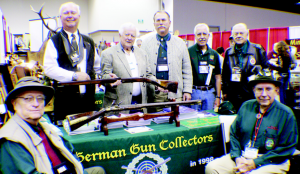Past President, NMLRA
This spring has been one great shooting sports event after another for me. It began with the 143rd National Rifle Association Annual Meeting and Exhibits, which was held April 25-27 in Indianapolis, IN. I have been attending the NRA Annual Convention for a few years now and this year it was extra special because it was held in the home state of the National Muzzle Loading Rifle Association. The NMLRA has had a booth at the NRA Annual Meetings for many years. This year the NMLRA had the opportunity to recruit members to the Association in their own backyard. Many new members signed up and many current members renewed.
One of the unique opportunities the NMLRA had this time was to sell tickets for the NMLRA’s Great Gun Raffle. There will be four lucky winners with the tickets being drawn Sept. 20, 2014. The winners will get to choose 1 of 4 rifles in the order the ticket was drawn. Grateful thanks go to each of the people and companies who donated these rifles. All of these guns have been donated to the NMLRA, so our Association does not have any money in them. All proceeds will go to the NMLRA.
The four rifles include a custom .45 cal. Southern Mountain style flintlock by Buddy Townsend. The heart of this traditional style rifle is a .45 cal. rifle barrel which was rifled on an 18th century style rifling machine made by Ron Greene. Many people pulled the rifling head through that barrel and learned about rifling or “cutting the groove.” I can’t begin to thank all the people who made that possible. It is a very good barrel and I am sure the new owner will be proud to own it.
Traditions donated the Vortek Strikerfire—this rifle has some of the newest technology available in muzzleloading. This in-line style rifle comes with a scope and is bore sighted right from the factory.
Knight Rifles donated one of their Mountaineer rifles, which features a Green Mountain barrel with DynaTek bore coating. This rifle is guaranteed at 200 yards for accuracy. The Knight and Traditions rifles will have product reviews in an upcoming issue of Muzzle Blastsmagazine, the NMLRA’s official journal.
The final gun was donated by Brownells. Brownells has been a great supporter of the NMLRA and the NMLRA National Championship Shoot. You can often see Brownells personnel on the firing line at our Championship shoots. They have donated their Daniel Defense M4 rifle for the raffle. Brownells was given the 2013 Daniel Defense Master Dealer of the Year Award and their M4 has become the choice rifle for 3-Gun competition.
Thanks again to each of the donors. Tickets sold like crazy at the NRA Convention for the drawing. It was about even on which gun would be picked first. If you are lucky enough to be one of the four winners, every rifle is a great choice.
There were many familiar faces and companies at the NRA convention. It was good to see Cletus Klein from Texas in the collectors’ section manning the German Gun Collectors Association booth. The GGCA was started in 1998 to preserve and promote German hunting and sporting guns. GGCA members were seen all over the show with their traditional German caps. Cletus had two of his beautiful flintlock Jaegers on display. He has been collecting muzzleloaders since his first trip to Indiana from Texas in the late 1950s, when he bought some of his first “collectibles,” which helped start his collection.
F.LLI Pietta had a large display of firearms at this year’s show. I talked to Dale Kimsey from Utah who was manning the booth. I was surprised how many commemorative cap-andball revolvers were made for the Civil War’s 150th Anniversary.
When I travel to different areas I am always interested in the local history, so I did a little reading up on Indianapolis history. Indianapolis became the Indiana State Capitol in 1820, although the capitol wasn’t officially moved from Corydon until January 1825. It wasn’t until the railroad began operation in 1847 that Indianapolis began to grow. During the Civil War, Indianapolis began to really expand and became a significant place on the map. The governor at the time, Oliver P. Morton, was a major supporter of President Abraham Lincoln. Indianapolis became a main supply depot and rallying point for Union forces before they entered Confederate lands.
Because it was a major railway hub, it also became the site of a major prisoner of war camp—Camp Morton. More than 3,700 Confederate prisoners would arrive after the battles of Fort Henry and Fort Donelson. There were always rumors that the Confederates were going to raid the prison to free Confederate soldiers but the closest the Confederates ever came to the city was Seymour, IN, which is over 60 miles away.
The Civil War left permanent marks on Indianapolis. An act made in Congress on July 11, 1862, established national arsenals at Columbus, OH, Indianapolis and Rock Island, IL. All three of these arsenals have survived to this day. The Indiana-run arsenal which operated from 1861-1864 was taken over for use as the Federal Arsenal in 1864. It was reported at one time that it housed over 100,000 rifles. The arsenal’s importance declined after the Spanish-American War and the US government authorized its closing in June of 1902. The arsenal building in Indianapolis is still in use as the Arsenal Technical High School and is located at 1500 E. Michigan St.
When traveling, for either work or pleasure, read up on the local history of the area you’re going to visit. You’ll be surprised what you can learn. For instance, did you know that Eli Lilly, the famous pharmaceutical business founder in Indianapolis, was commanding officer, 18th Battery, Indiana Light Artillery? Who knew?




